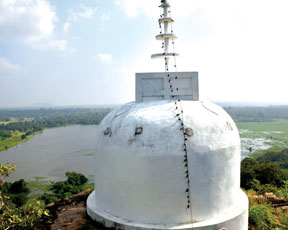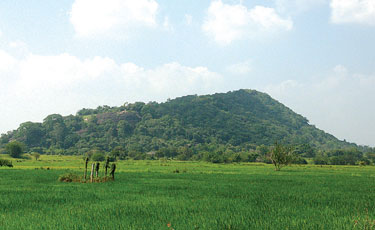Tharulengala, Sri Lanka’s longest cave
By Mahil Wijesinghe
The Tharulengala forest monastery, which lies several kilometres away
from Lahugala, houses the longest cave in Sri Lanka. It is on the
picturesque, newly-carpeted road from Pottuvil to Moneragala, in the
eastern part of the Ampara district.
 |
|
The area used by
Bhikkhus for meditation |
The stretch of lush green paddy fields in the flat land and the
enchanting and awe-inspiring ancient places such as Mudu Maha Vihara,
Kudumbigala and Magul Maha Vihara in the ancient Rohana province were
some of the breathtaking sights that we witnessed during a recent tour
of the area. The sight of the shrub jungle and thick forest of the
famous Lahugala National Park against the mild rays of the sun, ,
through the windscreen of the Mitsubishi 4DR5 jeep we were riding in,
was astounding. We were on our way from Lahugala, having risen early to
reach our destination - Tharulengala.
We passed acres of green forests on either side of the Lahugala –
Pottuvil Road where shrub jungle and farming land completed the
beautiful landscape. The heat of the scorching noon sun embraced us as
we headed for Hulannuge.
Hulannuge is a farming colony established in early 1943 with its main
road constructed in 1936. The forest engulfs the Karadahela Vihara. Even
today, leopards reign in this area while elephants and wild bears roam
freely.
The village in the Eastern Province constantly faced threats during
the era of terrorism. The village was attacked by the LTTE and all its
inhabitants were killed. I remember, eight years ago, a military
checkpoint where all vehicles entering and passing Hulannuge lined up
for inspection. The villagers are grateful to President Mahinda
Rajapaksa and the Security Forces and say the dark era is behind them
and they now live with fresh hopes and aspirations for their future.
Rocky mountain
A little beyond the junction of Hulannuge, there is a yellow notice
giving directions to the monastery. We turned right and drove along a
gravel road for about two kilometres to reach our destination, where the
historic Tharulengala forest monastery rises majestically against the
backdrop of lush green paddy fields. A rocky mountain and a white stupa
were visible on top of Tharulengala in the distance through green paddy
fields, about a kilometre along the road.
 |
|
The stupa and tank on
the mountain summit |
Tharulengala is another example of the ancient grandeur of
Digamadulla. Situated on a rocky boulder named Karadahela, the historic
place is close to the placid Hulannuge tank which lies in the slope of
the Karadahela Mountain. It is an example of the stupa and tank concept
(Wevai dagabai)of the irrigation system of a bygone era.
The place had been known as Karadahela Vihara and Habutagala Vihara
in the past. The monastery covers around 20 acres of thick jungle where
numerous stone ruins have long since been buried by rubble and time. In
1940, the entire area was enveloped in animal-infested forest and if
anyone ventured into its folds, it was for hunting. The Karadahela
Vihara is buried in this thick jungle.
King Kawantissa
The temple is believed to be the work of King Kawantissa, who ruled
the Kingdom of Ruhuna. The ruined structures are an indication of how
the place developed over time. The resident Bhikkhu of the Vihara told
us that this is believed to be the place where King Kawantissa built his
palace. Showing us the stone structures at the site, the Bhikkhu said he
believed that this must be where the palace had stood as more evidence
was unearthed from adjoining places such as Mudu Maha Vihara and Magul
Maha Vihara.
Today, the area is known as the Tharulengala forest monastery and is
administrated by the Chief Prelate of the Kudumbigala forest monastery.
Kudumbigala is about 40 kms west of the Kumana forest sanctuary in the
Yala East National Park, dates back to the Third Century and was a
reputed Buddhist monastery in the East.
When the Kudumbigala forest monastery was abandoned due to LTTE
activities in the Kumana forest, the Bhikkhus sought refuge in
Tharulengala to practise meditation. Tharulengala contains numerous
caves and provides a calm and quiet atmosphere for the Bhikkhus.
 |
|
The 41-foot Buddha
statue in the cave |
 |
|
The forest-covered cave
complex from a distance |
Parking our jeep at the slope of the hill, we began to climb
Tharulengala. A few metres before the cave, we came across a stone
inscription. Towards the mid-section of the hill, through the bushes, I
saw the main cave which had been converted into a shrine. The cave was
drip-ledged and was about 175 feet long and about 35 feet high. It is
home to a 41-foot reclining Buddha statue, built using bricks and clay.
The statue was severely damaged by treasure hunters and was beyond
recognition, but had been renovated later. There is no doubt, however,
that this must have been a magnificent Buddhist shrine in ancient times
when the Kingdom of Ruhuna was flourishing, but has decayed over time.
There is evidence that Veddahs had lived in the cave earlier. I
spotted Veddah drawings in the cave which are rapidly fading now.
Another important fact that I learned from the Bhikkhu is that the cave
catches the first rays of the rising sun from the East coast.
There are two stupas, a Buddha statue and a natural pond on the
summit of the rock in Tharulengala. One stupa was renovated and looks
like the Sanchi Stupa in India, although much smaller. Having climbed to
the top of the hill, I had a bird’s eye view of the entire Kumana and
Kudumbigala forest sanctuary, as far as the eye could see.
From the summit, we walked further into the forest, about half a
kilometre, through a footpath, and came across the most striking and
unique cave of Tharulengala. It is believed to be the longest cave in
Sri Lanka while some argue that it is also the longest cave in Asia. The
magnificent natural drip-ledged cave which is on the summit of the
Tharulengala is 512 feet in length.
We were captivated, having seen such a cave for the first time, and I
tried to photograph it from the beginning to the end, but failed due to
the uneven formation of the rock and the lack of space in front of the
cave. There is evidence that this cave was used by Bhikkhus; long
pathways, clay-plastered platforms and abodes made of clay are built
inside the cave for their use. The forest canopy in the vicinity would
have been an ideal place for meditation.
In addition to the long cave, there are several small caves scattered
on Tharulengala. All of these and several stone inscriptions have been
found near the site. On the eastern side of the hill, there lay several
ruined structures, believed to have been vandalised by treasure hunters.
The flight of steps which lead to the top of the summit shows signs of
serious decay.
Having seen the marvellous cave at the Tharulengala monastery
following information provided by an elderly man in Lahugala, we headed
back to the jeep with pleasant memories.
 |
|
A drawing depicting the
full length of the cave |
|



